I'm finding that I quite enjoy getting up at the crack of dawn, to enjoy the sunrise, the morning air, the birds, the scenery in the morning light... I really feel at peace...
We started the day by getting up early to take photos of birds and the mountains. After breakfast and after leaving our laundry with the San Lodge staff (they do laundry (wash, line dry, and fold) for you for 35 Rand - wheee!), we were ready to go on a daytrip to Lesotho!
We met our guide and got into a 4X4 vehicle; you need one of those to drive up Sani Pass and you can actually be stopped and made to turn back if you don't have an appropriate vehicle. I was a bit apprehensive at first as there were no seatbelts in the 4X4 and if something were to happen, the insurance companies would go tell me to bite myself. As we drove along, our guide casually mentioned something or other about how if the driver jumps out of the vehicle, that everyone should jump out... just as well there were no seatbelts ;-)
Anyway, we drove up along the Sani Pass, which is used as a trade route between South Africa and Lesotho. The actual road is nuts – unpaved, narrow, steep, twisting. It's why you need a 4X4. And even with 4X4s people had problems. We saw at least two breakdowns during the whole trip. Anyway, drivers going up have the right of way, and I can see where this rule can be difficult for drivers going down. Along the Sani Pass as a whole, you could see the remains of cars and trucks that have driven off the road. Not a pretty sight. I'm glad we chose an organized tour as opposed to doing it on our own. We didn't have a 4X4 for starters...
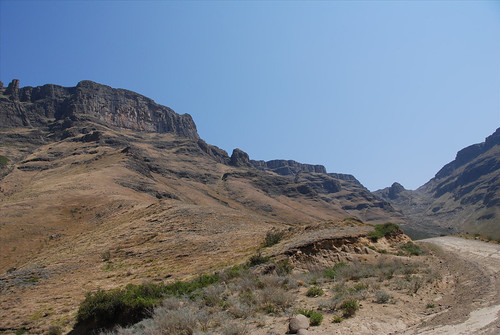
Originally, donkey-pulled carts were used but now even big trucks (eek) use the road. There were several old trade posts (houses) along the way; we stopped at these for closer looks and photographs. There were quite a few interesting stops along the way, which was good as there were so many nice things to see and photograph. There were lots of weird things too. Like this one dude who was carrying a big bundle of branches on his back. As we were in a World Heritage site, it was not legal to take things like branches from it. However, according to our guide, this guy did it day in and day out...
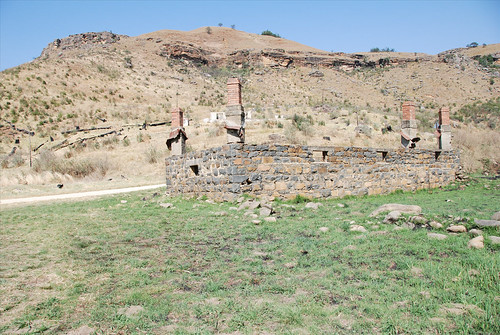
Another interesting section was a mountain route used for marijuana smuggling. The Lesothan government did little to stop the traffic from Lesotho to South Africa, leaving the South African border police with the bulk of the work. Lesotho is a poor country and with poverty comes the desire to make “quick and easy” money, legally or not...
The vegetation was also quite interesting, varying tremendously between the Sani Lodge and Lesotho itself. It's amazing how much differences in altitude affect things...
Unfortunately, there are plans to pave this road, and work has already started. I say unfortunately, as maintenance of the road will be expensive, and because it takes away a lot of the charm of the area. Tourists specifically traverse the Sani Pass because the road is so primitive and harrowing. In addition to the plans to pave the road, there are plans on building more luxury resorts in the area, as well as setting up a ski resort in Lesotho. Among the arguments to counter the arguments that this will ruin the environment, "but it will help the local economy." Bullshit. Lesothans
Heh, speaking of "abroad," our guide was talking about this tour agency called Saga, dubbed "send a granny abroad" by a lot of local guides. They allegedly sell relatively "tame" package tours to the elderly, and they always had to get back to the luxury lodge by a certain time, so that the old folks could take their medication ;-)
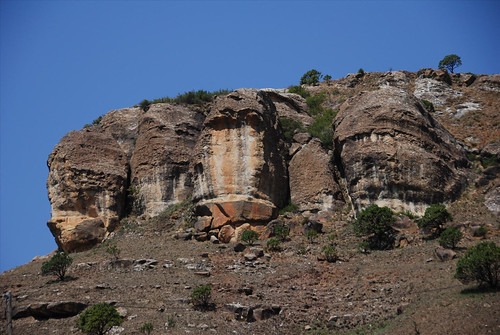
Anyway, when we got to the border control to go out of South Africa, there weren't too many people there. However, the queue grew and grew, so it was a good thing we got there when we did. It was a public holiday, so there were crowds. But things went quickly and smoothly. We then went to the passport control at the Lesotho border and that went smoothly as well. Our guide had taken all our passports in, and when he returned with them there was a Lesothan border guard with him. He looked at me and said “you're feitpingvin!” Really weird. I said yes, I am, and I shook hands with him. He said that he had seen my passport, which is what I figured. So we got back into the vehicle and yay! We were finally in Lesotho! We can finally fill in that darn spot in the middle of South Africa in our “countries visited” maps ;-)
The part of Lesotho we visited is very isolated and barren. There were no trees to be seen due to the high altitude; only dryish shrubs. The primary industry in Lesotho is sheep farming (for wool), as sheep and goats are the only thing that can survive and be "grown" there.

Young Lesothan men spend time in these isolated areas to work/train as shepherds, from the age of 13 or so. They live a very simple life, but they are able to get a piece of land for free. They don't go to school as they have their land and their sheep; they don't need very much else. Schooling is not compulsory in Lesotho, but primary education is free, and 85% of the population is literate, which is high by African standards. Secondary education is not free and thus limited to the wealthy who can afford it. University education, on the other hand, is free. It's really weird that secondary education isn't free but everything else is...
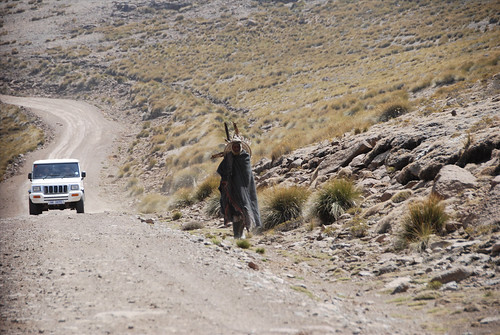
It was a very windy day, and we got lots of reddish-brownish dust blown all over us... urk. We were washing it out for days. The wind made it quite chilly too...
Not too long after lunch, some of us went out for a hike with the guide; a woman with three small children stayed behind in the vehicle. The hike was very nice, but we could really feel the effects of the thin air. It took a lot more effort to do something as simple as walk for a half hour than it would normally take at, hmm, sea level...

When we returned to the vehicle, there was a shepherd there. Just standing there. As if he appeared from nowhere. Very spooky...
We started heading back towards the border. Our next stop was at a private rondawel (or rondavel – it can be spelled both ways), to visit one of the locals. We met a lovely woman who sells bread, beer, homemade beer (similar to umqombothi, made of maize and sorghum – if anyone knows that the local term for this "beer" is, let me know!), and other things to shepherds and tourists. We got to sample the homemade beer (this was passed around in a big mug), which was actually quite nice, refreshing, and fruity, as well as the bread (also passed around), which was absolutely delicious. The bread was wholegrain and very flavorful; it came in large, triangular chunks. This was the kind of bread that appeals to northern Europeans. Yum yum! We were told we could buy some bread if we wanted to, so we bought a few pieces (we could pay with ZAR). Boyfriend of feitpingvin bought a big bottle of regular beer as well, even though he could have easily purchased beer in South Africa. It's always nice to help out the locals, especially when they have six kids to feed!
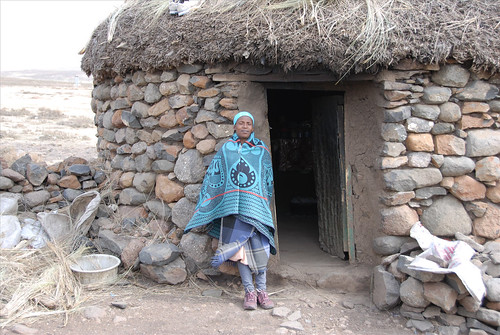
I was a bit disappointed to not find wool products for sale, like the beautiful bright-colored shawl/poncho-thing the woman was wearing. I would have loved to have something like that!
On a side note, the Lesothan vendors usually had a colored flags code system to let shepherds and whoever else know what was being sold. I don't remember what color was for what though.
Our final stop was at the Sani Top Chalet, to visit Africa's highest pub. This was something for Mini Wolfgang for sure! He had been rather bored for most of the trip ;-)
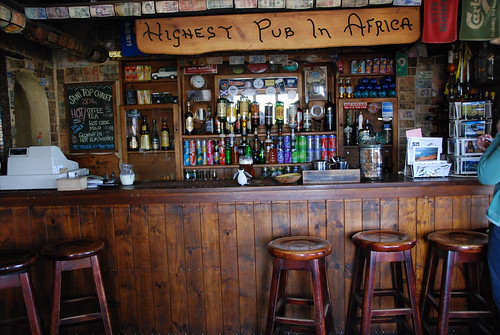
We shared a mug of hot cocoa (yum) and a pint of beer (Mini Wolfgang drank most of that) and took some photos in the general area. The beer on tap was from the Nottingham Road Brewing Company – yay! :-D
Along our return to South Africa and the Sani Lodge, we stopped by this place called "the Fountain of Youth," where we could drink the streaming water.
When we returned, our laundry was washed, dried, and folded, which was nice. The electricity had gone out though, which made things interesting. The common area was lit with candles, and we were wondering how dinner would be handled (we booked dinner again). It wasn't a problem as the stoves were gas, and we had a simple, but filling dinner.
The electricity came back eventually, but it didn't really matter for us. Again, we went to bed at 21:00...
* From what I have heard, it is offensive to call them “Lesothans.” I don't know if it comes from the mouths of the people of Lesotho, or if the PC-brigade has stuck their nose where it doesn't belong once again. If I'm going to have to use each individual ethnic group, then I have to know who/what they actually are. So if someone can let me know what the people of the Sani Pass area of Lesotho are “supposed” to be called, I'd appreciate it.

1 comment:
We are Basotho (pl.): "Hey, look at those Basotho riding their ponies home!"
Alone, I am a Mosotho (sing.): "I have a Mosotho friend."
"Lesothans" does not really exist, and is just an occidental invention to facilitate life for reporters there.
I wouldn't like to be called that.
Wishing you happy holidays and a good New Year
Post a Comment